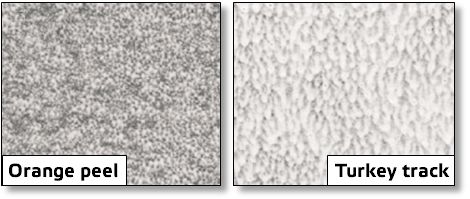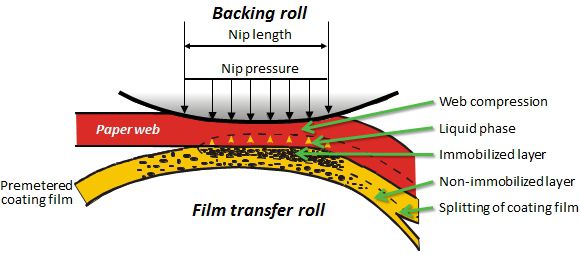The mechanics, factors and prevention of size press orange peel
A common problem on film metering size presses is orange peel. Orange peel is caused when the coating film splits away from the coated sheet in the immobilized coating layer at the exit of the size press nip. Two examples of orange peel are shown in Figure 1.

Figure 1 Orange peel patterns on wood-free paper, left image is 10 g/m2, right image is 27 g/m2 i.e. "turkey track".
A thin film of non-immobilized coating is required to allow the coating to split uniformly between the immobilized and non-immobilized coating layers. This means a small amount of wet coating needs to follow the roll after the nip. The transfer rate cannot be 100%. If some wet coating doesn't follow the roll after the nip on a controlled basis, it can dry on the applicator roll and cause coating streaks which eventually cover the entire roll. This can cause runnability and quality issues.

Figure 2 Coating film splitting in a size press nip.
Figure 2 shows the mechanism of film splitting. The coating is transferred to the paper as a forward roll process in the nip between two rolls. The coating / paper interaction in the nip determines how much of the pre-metered coating film transfers to the paper, as well as the runnability properties of the process and the final quality of the coated surface. How much of the pre-metered coating film is finally transferred to the paper is dependent on several issues. Some of the most important parameters in this process are:
- time available in the roll nip,
- fill-in of the sheet structure during coating penetration,
- water absorptivity of the base paper,
- dewatering and immobilization of the coating layer,
- elasticity of the non-immobilized coating when the film splits on web release,
- roll cover thickness and hardness.
As mentioned above, several factors determine how the film split occurs. Most of these are determined by the properties of the coating and how it dewaters as it is pressed against the paper in the nip. However paper absorptivity and smoothness also play a role.
On slower machines, the rate of coating dewatering must not be too fast or roll deposition and orange peel will result. The coating should have enough water holding capacity to prevent coating from sticking to the roll. Factors that influence water holding characteristics of the coating include lower solids, addition of soluble thickeners, and higher liquid phase viscosity. Process settings that help reduce coating buildup on the rolls include running higher film thicknesses, reduced nip pressure, lower rod pressure, and reduced sheet porosities. Softer roll covers also help by reducing nip pressure.
On fast machines, the coating must dewater fast enough to keep the non-immobilized layer thin. Higher coat weights, liquid phase viscosity, and machine speed increases orange peel. Higher coating solids helps reduce orange peel at high machine speeds whereas low coating solids lose too much water into the sheet and increase orange peel. Ideally, coating solids should be kept as high as possible while at the same time maintaining a low liquid phase viscosity. Thickeners and co-binders of low molecular weight at low addition levels help reduce orange peel look by modifying liquid phase viscosity.
For more information on overcoming chronic coating problems, contact your Valmet representative.